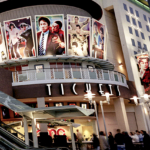The business model for Entertainment Districts is built around the natural human desire for congregant entertainment experiences.
Key Insights
- Entertainment Districts deliver a variety of entertainment and retail venues to consumers, making them durable even in economic downturns
- There is a movement by existing malls toward the Entertainment Districts approach, so further growth and evolution is likely
Meeting the Need for Variety
The desire for out-of-home entertainment is a longstanding consumer trait, and Entertainment Districts deliver the variety that today’s consumers expect. Entertainment Districts consist of many venues, which can include shopping, fitness centers, restaurants, movie theatres and breweries—and are anchored by a movie theatre or live performance venue. This broad selection of entertainment options creates a convenient and engaging experience for consumers who want to park the car one time, then dine, shop, and experience different forms of entertainment.
And that’s precisely why the property type enjoys success. The business model for Entertainment Districts is built around the natural human desire for congregant entertainment experiences. Even as online shopping becomes increasingly popular, people still desire out-of-home shopping and entertainment experiences. Recognizing the impact online shopping has had on retailers, there is an increased focus on establishing entertainment venues as anchors for properties. Across the country, companies are redeveloping and expanding older shopping centers to fit into the Entertainment Districts category.
Similar to traditional malls and shopping centers, Entertainment Districts are anchored by megaplex theatres or live performance venues. The supporting retail and entertainment offerings extend the visit by maintaining excitement and energy that encourages consumers to continue their experience.
Several facets of Entertainment Districts make them durable:
- Entertainment Districts offer an escape from the challenges of daily life.
- With alternatives offered along the spectrum of entertainment, consumers have a wide variety of options to choose from.
Millennials Mark the Future
Successful Entertainment Districts also offer a variety of entertainment options that create a destination property for an assortment of market segments; couples, kids, families, etc. With more than 70 million consumers aged 18-35, the Millennial Generation is the highest spending demographic. Entertainment Districts appeal to the evolving tastes of Millennials, which expects choices in entertainment. With customized options like themed event nights and revolving menu items, Entertainment Districts properties are able to change quickly and appeal to this key demographic.
80% of Millennials go out for dinner multiple times a month—with a preference for table service.
The Millennial Generation enjoys shopping and frequently visits shopping centers. More than 2/3 of Millennials visit big-box centers at least once a month, and 65% bring friends and family with them. However, according to Urban Land Institute, the challenging corollary is that 18- to 35-year-olds are bored easily, so they’re on the lookout for new excitement—online and in brick-and-mortar settings. Sensory aspects of retail facilities must evolve constantly in order to retain young shoppers’ patronage. This is an area where Entertainment Districts are poised for success.
Millennials report three of the greatest factors in driving them to shopping centers are lots of options (53%), a chance to get out (42%) and good places to eat (28%). New experiences are also popular, with an emphasis on affordability.
Looking Forward
CNBC reports that more and more failed big-box stores and struggling strip malls will look to follow the Entertainment Districts model of success. Many older centers are getting facelifts, particularly those in urban areas where residents have above-average incomes. Entertainment Districts are the next generation in “mixed-use” locations that deliver an enhanced entertainment retail experience. Development in suburban markets, stagnant over the past decade, is expected to pick up in the years ahead as rebounding home sales and values help fuel slow but steady growth in consumer spending.
Adding more entertainment options is an important part of redevelopment, experts said, because malls need to give families a reason to come in and shop rather than just purchase items online from the comfort of their homes. And because of changes in big-box retail offerings, property should be available for Entertainment Districts to continue growth into the future.
Sources
Across the Corridor and The Nation, Malls Get New Identities. The Iowa Gazette. Web. 2014. 25. Jan. 2014.
Generation Y: Shopping and Entertainment in the Digital Age. Urban Land Institute. Web. 2013. 6. Jan. 2014.
Mixed Use in an Overretailed Landscape. Urban Land Institute. Web. 2013. 8. Jan. 2014.
Guess What’s Replacing Stores in Your Local Mall?. CNBC.com. Web. 2012. 28. Nov. 2013.ov. 2013.






